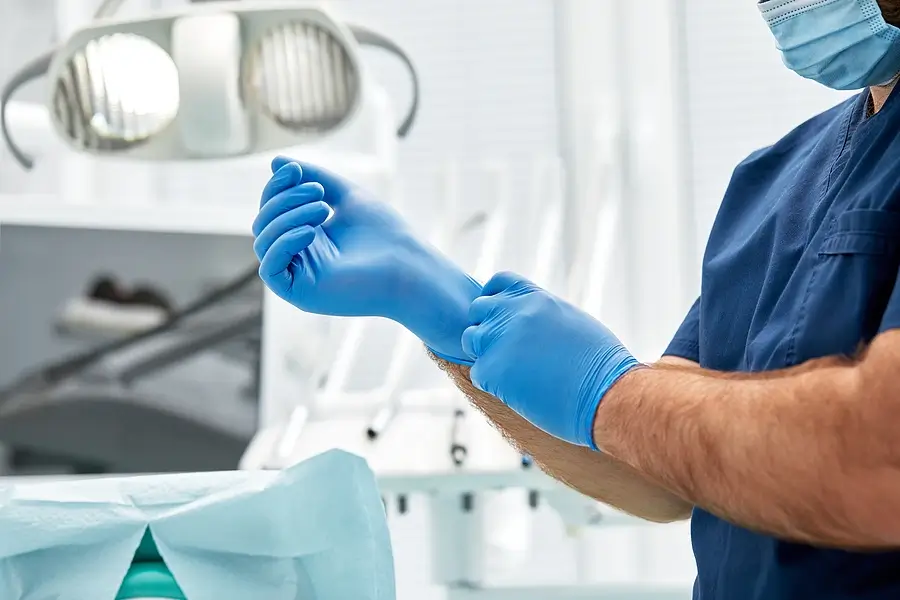The Vital Role of PPE in Dentistry
Personal Protective Equipment, commonly referred to as PPE, is a common phrase heard in the healthcare industry. However, many healthcare workers overlook its importance and fail to understand the reasoning behind its implementation. In the field of occupational health and safety, a crucial concept is the Hierarchy of Hazard Control, often depicted as a pyramid. This hierarchy helps determine actions to control exposures, with five levels ranked by their effectiveness, from 1 (most effective) to 5 (least effective):
- Elimination: Elimination removes the hazard at the source.
- Substitution: Substitution is using a safer alternative to the source of the hazard.
- Engineering Controls: Engineering controls reduce or prevent hazards from coming into contact with workers.
- Engineering controls can include modifying equipment or the workspace, using protective barriers, ventilation.
- Administrative Controls: Administrative controls establish work practices that reduce the duration, frequency, or intensity of exposure to hazards.
- Personal Protective Equipment: PPE is equipment worn to minimize exposure to hazards.
In the dental field, applying the first three levels of hazard control is challenging without completely altering the way dental practices operate and procedures are conducted. This is why it is crucial to emphasize the importance of personal protective equipment, especially when accompanied by administrative controls. PPE implementation serves as the last line of defense for the protection of Ontario Healthcare Workers (OHCWs). If this equipment is not worn or its integrity is compromised, OHCWs face a significantly increased risk of exposure to infectious materials.
Not only is using PPE a logical precaution, but it is also mandated by the Occupational Health and Safety Act of Ontario, Regulation 67/93. According to this regulation, workers at risk of hazard exposure must be provided with appropriate PPE. Employers are also responsible for providing training on its care, use, and limitations before its initial use and at regular intervals. PPE should be properly used, maintained, fit, inspected for damage, and stored in a convenient, clean, and sanitary location when not in use.
Beyond regulatory requirements, PPE is recognized by the Royal College of Dental Surgeons (RCDSO) and the College of Dental Hygienists of Ontario (CDHO) as a vital standard of practice in the dental industry. PPE acts as a barrier to protect healthcare workers’ exposed tissues from infectious materials, including blood, body fluids, saliva, conjunctival mucosa of the eyes, respiratory tract mucosa, and puncture injuries when at risk of sharps exposure.
PPE in dental practice typically includes masks, gowns, protective eyewear and/or face shields, and gloves. Specifically, gowns should meet the fluid-resistant level 2 or higher criteria and cover sleeves, the front and back of the body from the neck to the thigh, overlap in the back, and securely fasten. It’s important to note that laboratory coats or jackets are not considered part of this category. Disposable gowns are recommended, as laundered gowns require a specific procedure to maintain their effectiveness. It is crucial to emphasize the proper use and maintenance of masks, protective eyewear, and gloves in dental practice for the safety of both healthcare workers and patients.
Masks that effectively cover the nose and mouth must be consistently worn during dental procedures to safeguard the respiratory mucosa of staff. It is essential to change masks between patients because they can become wet from the exhalation of healthcare workers, which diminishes their effectiveness as a barrier. Protective eyewear serves as a vital defense against spatter, debris, and potential exposure to sharps or foreign objects. It is essential for both staff and patients. These eyewear items must be cleaned, disinfected, and inspected between patients to ensure their continued effectiveness. Gloves are among the most common types of protective barriers used in the healthcare industry. However, due to their frequent use, they are also at a higher risk of damage. As such, healthcare workers must be vigilant in inspecting gloves for any signs of compromise and change them as needed. Proper glove usage is critical to prevent the transmission of infectious materials and maintain the highest standards of safety and hygiene.
In addition to proper use, maintenance, and regular replacement of masks, it’s essential to mention the significance of fit testing. Fit testing is a critical procedure that ensures the proper fit of masks, especially those designed to offer respiratory protection, such as N95 respirators.
Fit testing is conducted to confirm that the mask seals securely to the face of the wearer, leaving no gaps that might allow harmful particles or pathogens to enter. This process is crucial because an ill-fitting mask can significantly compromise its effectiveness. It’s important to note that not all masks require fit testing, but for those that do, it is a mandatory step in maintaining their integrity.
One common misconception or trend that I have observed during assessments in dental practices is that staff often assume that PPE arrives in perfect condition from the manufacturer. Consequently, the crucial procedure of checking the integrity of PPE is frequently overlooked. It is of paramount importance to establish a process for inspecting PPE for any signs of degradation. If the PPE is compromised, its protective barrier becomes ineffective, potentially exposing healthcare workers to hazardous materials.
In conclusion, a comprehensive understanding of PPE, its hierarchy in hazard control, regulatory compliance, proper use, maintenance, and fit testing, is essential in dental practice. Prioritizing the safety of healthcare workers through effective PPE utilization is not only a legal and professional obligation but also a fundamental aspect of providing high-quality dental care.

